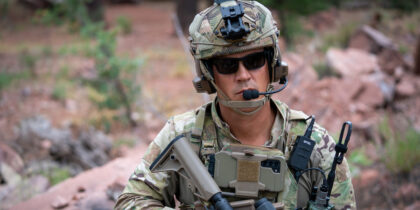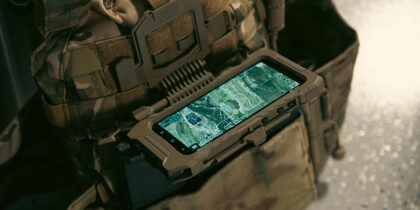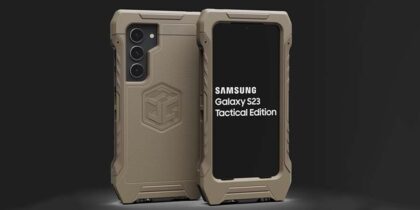In 2011, while deployed in Afghanistan, Adam Hardage awoke with vision loss and vertigo. That alarming health issue led to a clinic visit at Kandahar Airfield, which resulted in no diagnosis. Evacuated to Bagram Air Base, Hardage again left with no diagnosis. After being flown stateside, a doctor with the U.S. Department of Defense speculated that Hardage might have a brain tumor, but again offered no definitive diagnosis. Finally, upon returning to Tampa, Florida, and consulting with neurologists and specialists, Hardage got an answer: relapsing multiple sclerosis (MS).
After several weeks of treatment, Hardage’s vision and balance returned. Today, he leads a normal, active lifestyle. But that experience of going weeks without a diagnosis, visiting clinics that could not easily share information, and lacking easy, remote access from the field to doctors and specialists that could have easily diagnosed his MS, made an impression on Hardage. Though his condition was serious, how much worse would it have been if he had been critically injured and needed immediate lifesaving care?
Roughly five years later and inspired by that experience, Hardage co-founded Remote Health Solutions (RHS) with his brother-in-law, Dr. Jonathan Baugh. Today, RHS finds and then combines technologies that make it easier to provide medical assistance, whether for the military in the field or care workers in remote settings underserved by medical facilities. A specific area of focus for RHS is the U.S. military operating in what are known as disconnected/delayed, intermittent and low-bandwidth (DIL) communication environments that make it difficult to share data and video over existing communications infrastructure. RHS formulated a solution for just such an environment, combining multiple technologies that make it easier to gather patient information, share that information with doctors and specialists, and even collaborate via video when needed.
A solution designed for military field operations
The RHS solution combines three key technologies:
- Battlefield Assisted Trauma Distributed Observation Kit (BATDOK™) Software: Created and owned by Air Force Research Laboratory’s 711th Human Performance Wing, BATDOK software runs on mobile devices and allows users to collect real-time patient information, track vitals and document treatment.
- Virtual Exam Room (VER): Developed by Dictum Health, VER provides a telemedicine video consultation platform, electronic health record (EHR) integration, plus a real-time data streaming capability.
- Galaxy S20 Tactical Edition: The latest in Samsung’s line of mission-ready, military-grade smartphones, the Tactical Edition has been tested and fielded in special operations environments. The phone connects seamlessly with tactical radios and mission systems.
“Each of these technologies is available separately,” Hardage notes. “But it’s only when they are combined within the tactical ecosystem that they offer something powerful and user-friendly that every medic in the field wants.” RHS offers the only commercially available solution that seamlessly combines all three.
Before the advent of this solution, military field medics didn’t have a reliable way to consult with doctors in real time, sharing live video and patient data. These communication issues were exacerbated in events with multiple casualties. The inability to share patient information in addition to poor communication leads to wasted time, directly impacting the quality of care. For field personnel, RHS offers a ready-to-go solution that overcomes these challenges, meets military security standards and operates in DIL environments.
Greater than the sum of its parts
When military operations order this solution from RHS, the Galaxy S20 comes loaded with VER-enabled BATDOK software and any required back-end licenses.
The Galaxy S20 Tactical Edition has several key advantages, says Hardage. It’s the only commercially available off-the-shelf smartphone line that is approved for use in classified communications and proven operationally ready by special forces. A big part of that is Samsung’s defense-grade Knox security platform, including unique capabilities like Dual Data-at-Rest Encryption.
Enhance critical incident response with mobile
Learn how to execute safer, more effective incident response with a mobile-first approach. Download Now
With BATDOK loaded onto the S20 Tactical Edition, field medics can wirelessly monitor multiple patients’ vitals simultaneously. The software makes it easier to gather patient information — even in volatile environments. Medics can quickly capture full patient history, describe treatment from the point-of-injury through medical evacuation and assist with follow-up guidance that transfers to the patient’s next stage of care.
RHS then facilitates communication with that next level of care by equipping the solution with VER capabilities. VER moves video, voice and data — even over very low bandwidth infrastructure. By compressing video, voice and data down to as low as 160 Kbps, medics can communicate over nearly any grade of internet connection from 3G, 4G, LTE and satellite. That connection can be invaluable if a field tech needs immediate access to a doctor for advice on patient care. Samsung helps RHS package everything as a preconfigured unit. “Everyone involved with the solution wants what is best for the end user,” says Hardage. “With the streamlined order process, everything is taken care of before delivery. That completely removes the logistical burden out of the supply chain.”
Hardage’s own healthcare experience, while he was in the military, adds personal meaning to the work RHS does. “We’re proud to put products together for the military community,” he says. “There’s nothing more special to us at RHS than being able to help those who have been wounded in the service of our country.”
Learn more about the mission-ready mobility of the Samsung Galaxy S20 Tactical Edition. And discover how mobility can help hyper-enabled operators achieve cognitive dominance.









